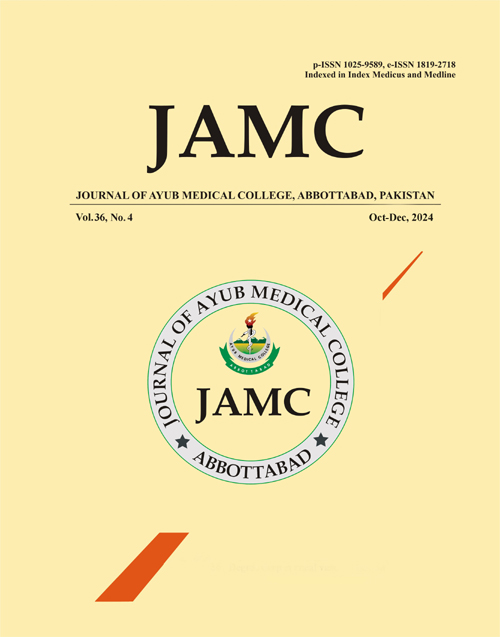EFFECTIVENESS OF YOUTUBE AS AN EDUCATIONAL TOOL FOR TEACHING ORTHODONTICS TO UNDERGRADUATE DENTAL STUDENTS
DOI:
https://doi.org/10.55519/JAMC-04-12740Keywords:
Teaching tool; Orthodontics; Medical Education; E-Learning; YouTube.Abstract
Background: The advent of modern technology has dramatically influenced the availability of resources for students to learn and gain knowledge as well as improve their skills. Methods: Over six months, a randomized control trial (pretest-post-test design) was conducted at Khyber College of Dentistry, Peshawar. The aim was to compare the traditional method with YouTube learning to enhance students' diagnostic skills in lateral cephalometry and benefit the local dental community. Results: Seventy-four participants took part, with an average age of approximately 23 years having 35.1% male and 64.9% female participants. The control group's pre-test mean score was 5.54, significantly increasing to 13.62 in the post-test. The experimental group's pre-test mean score was 4.08, significantly rising to 15.29 in the post-test. The experimental group outperformed the control group in the post-test, with mean scores of 15.29 and 13.62, respectively. Participants showed overall satisfaction with course content, materials, instructor knowledge, and YouTube learning, though opinions on class location and equipment varied, with some expressing less satisfaction in this aspect. Conclusions: This current study signifies the use of YouTube as a teaching tool. YouTube based learning had a superior efficacy to traditional based learning for instruction of cephalometric landmarks identification.
References
1. Golshah A, Dehdar F, Imani MM, Nikkerdar N. Efficacy of smartphone-based Mobile learning versus lecture-based learning for instruction of Cephalometric landmark identifi-cation. BMC Med Educ 2020;20(1):287.
2. Di Lu J, Cameron BH. The effectiveness and challenges of E-learning in surgical training in low-and middle-income countries: a systematic review. Glob Health Ann Rev 2020;1(5):59–62.
3. Burns LE, Abbassi E, Qian X, Mecham A, Simeteys P, Mays KA. YouTube use among dental students for learning clinical procedures: A multi‐institutional study. J Dent Educ 2020;84(10):1151–8.
4. McIntosh K, Hirsch MS, Bloom A. Coronavirus disease 2019 (COVID-19). UpToDate Hirsch MS Bloom 2020;5(1):873.
5. Nagendrababu V, Pulikkotil S, Sultan O, Jayaraman J, Soh J, Dummer P. Effectiveness of technology‐enhanced learning in Endodontic education: a systematic review and meta‐analysis. Int Endod J 2019;52(2):181–92.
6. Karim J, Marwan Y, Dawas A, Esmaeel A, Snell L. Learning knee arthrocentesis using YouTube videos. Clin Teach 2020;17(2):148–52.
7. Adams GL, Gansky SA, Miller AJ, Harrell Jr WE, Hatcher DC. Comparison between traditional 2-dimensional cephalome-try and a 3-dimensional approach on human dry skulls. Am J Orthod Dent Orthop 2004;126(4):397–409.
8. Jacobson A, White L. Radiographic cephalometry: from basics to 3-D imaging. Am J Orthod Dent Orthop 2007;131(4):S133.
9. Kobayashi K, Shimoda S, Nakagawa Y, Yamamoto A. Accu-racy in measurement of distance using limited cone-beam computerized tomography. Int J Oral Maxillofac Implants 2004;19(2):228–31.
10. Pilieci SN, Salim SY, Heffernan DS, Itani KM, Khadaroo RG. A randomized controlled trial of video education versus skill demonstration: which is more effective in teaching sterile surgical technique? Surg Infect 2018;19(3):303–12.
11. Abdelaziz M, Kamel SS, Karam O, Abdelrahman A. Evalua-tion of E-learning program versus traditional lecture instruc-tion for undergraduate nursing students in a faculty of nurs-ing. Teach Learn Nurs 2011;6(2):50–8.
12. Reime MH, Harris A, Aksnes J, Mikkelsen J. The most suc-cessful method in teaching nursing students infection con-trol–E-learning or lecture? Nurse Educ Today 2008;28(7):798–806.
13. Soltanimehr E, Bahrampour E, Imani MM, Rahimi F, Almasi B, Moattari M. Effect of virtual versus traditional education on theoretical knowledge and reporting skills of dental stu-dents in radiographic interpretation of bony lesions of the jaw. BMC Med Educ 2019;19(1):233.
14. O'Leary FM, Janson P. Can e‐learning improve medical stu-dents' knowledge and competence in paediatric cardiopul-monary resuscitation? A prospective before and after study. Emerg Med Australas 2010;22(4):324–9.
15. Leasure AR, Davis L, Thievon SL. Comparison of student outcomes and preferences in a traditional vs. world wide web-based baccalaureate nursing research course. J Nurs Educ 2000;39(4):149–54.
Downloads
Published
How to Cite
Issue
Section
License
Copyright (c) 2024 Syed Suleman Shah, Brekhna Jameel, Wasim Ijaz, Naveed Iqbal, Humera Adeeb, Siyyar Ahmad

This work is licensed under a Creative Commons Attribution-NoDerivatives 4.0 International License.
Journal of Ayub Medical College, Abbottabad is an OPEN ACCESS JOURNAL which means that all content is FREELY available without charge to all users whether registered with the journal or not. The work published by J Ayub Med Coll Abbottabad is licensed and distributed under the creative commons License CC BY ND Attribution-NoDerivs. Material printed in this journal is OPEN to access, and are FREE for use in academic and research work with proper citation. J Ayub Med Coll Abbottabad accepts only original material for publication with the understanding that except for abstracts, no part of the data has been published or will be submitted for publication elsewhere before appearing in J Ayub Med Coll Abbottabad. The Editorial Board of J Ayub Med Coll Abbottabad makes every effort to ensure the accuracy and authenticity of material printed in J Ayub Med Coll Abbottabad. However, conclusions and statements expressed are views of the authors and do not reflect the opinion/policy of J Ayub Med Coll Abbottabad or the Editorial Board.
USERS are allowed to read, download, copy, distribute, print, search, or link to the full texts of the articles, or use them for any other lawful purpose, without asking prior permission from the publisher or the author. This is in accordance with the BOAI definition of open access.
AUTHORS retain the rights of free downloading/unlimited e-print of full text and sharing/disseminating the article without any restriction, by any means including twitter, scholarly collaboration networks such as ResearchGate, Academia.eu, and social media sites such as Twitter, LinkedIn, Google Scholar and any other professional or academic networking site.










